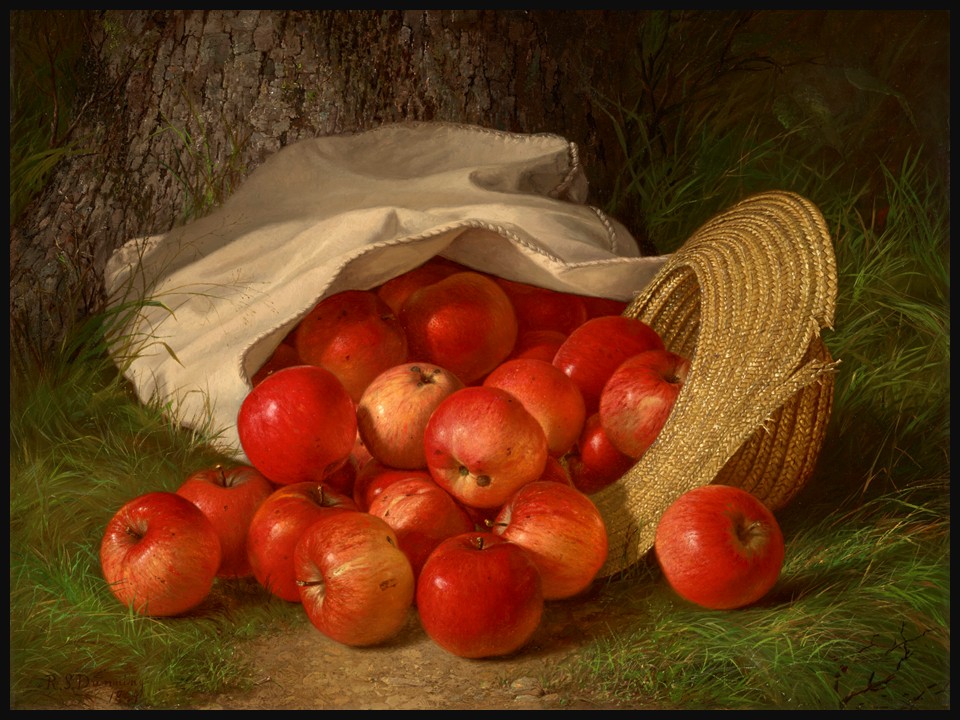
Apples, 1869, Oil on Canvas, 50.2 x 64.1 cm, Private Collectionhttps://www.christies.com/en/lot/lot-6519615?ldp_breadcrumb=back
When I look at Robert Spear Dunning’s Apples, I can’t help but think of Robert Frost’s words… But I am done with apple-picking now. / Essence of winter sleep is on the night, / The scent of apples: I am drowsing off… from After Apple-Picking. The painting, like the poem, holds that quiet pause between abundance and rest, when the harvest is gathered in and time itself seems to slow. Yet it also makes me think about World Food Day, held each year on October 16, when more than 150 countries come together to raise awareness of hunger and poverty. Dunning’s apples, so rich and full, remind me how easily we take such everyday nourishment for granted, and how vital it is that food and beauty alike are shared more widely. https://www.poetryfoundation.org/poems/44259/after-apple-picking
Robert Spear Dunning (1829–1905) was an American painter best known as a leading figure of the Fall River School, a circle of artists in Massachusetts devoted to still-life painting. Born in Brunswick, Maine, he studied at the National Academy of Design in New York under Daniel Huntington, where he developed both academic discipline and a meticulous eye for detail. By the late 1850s, Dunning had settled in Fall River, and in 1859 he helped establish the Fall River School, transforming southeastern Massachusetts into an unexpected hub for still-life painting. Over his long career, he exhibited widely and gained recognition for elevating the still life, particularly fruit compositions, into a respected and celebrated genre of American art.
In 1870, Dunning expanded his influence further by co-founding the Fall River Evening Drawing School with fellow artist John E. Grouard. Created to make art education accessible to the city’s working population, many of whom toiled in the textile mills, the school emphasized drawing as the essential foundation for artistic practice. It quickly became a cultural center for aspiring painters and helped solidify the identity of the Fall River School, whose members became known for their luminous and painstakingly detailed still lifes. By offering structured training outside the major urban art centers, the Evening Drawing School broadened the reach of American art education and left a lasting imprint on the cultural life of the region.
Dunning’s aesthetic is marked by clarity, precision, and a refined sense of order. His canvases often feature fruit arranged with deliberate symmetry, their surfaces rendered in luminous detail that balances realism with quiet idealization. Apples, grapes, peaches, and plums are polished to near perfection, often set against dark or neutral backgrounds that heighten their rich colors and tactile presence. This combination of natural abundance and painterly restraint gives his work both elegance and restraint, transforming everyday objects into meditations on beauty, transience, and plenty.
Robert Spear Dunning’s Apples (1869) stands as a quintessential example of American still-life painting in the 19th century, showcasing the artist’s unrivaled precision and luminous treatment of everyday subjects. The composition places apples at the center of attention, their polished surfaces glowing with quiet richness against a subdued background. This balance between meticulous detail and atmospheric harmony reflects Dunning’s mastery of elevating simple fruit into a timeless meditation on abundance and beauty. Works like Apples helped establish the reputation of the Fall River School, positioning Dunning as one of the foremost still-life painters of his generation.
The painting has also enjoyed a distinguished journey through the art world. Originally in a private Massachusetts collection, it was sold at Christie’s New York in 1985, later entering the renowned Manoogian Collection before passing through Michael Altman Fine Art in New York. Its reappearance at Christie’s in January 2025, in the sale American Sublime: Property from an Important Private Collection, confirmed its enduring appeal: estimated at $100,000–150,000, Apples realized $100,800. Both as a work of art and as an object of collecting, Dunning’s Apples remains a striking testament to the lasting value of beauty captured with honesty and care.
Just as Robert Frost’s apple-picking drifts toward sleep, Robert Spear Dunning’s Apples seems to pause time, the fruit perfectly gathered, yet on the verge of passing. It’s a reminder that the beauty of harvest is always fleeting, and that food, so ordinary in appearance, is in fact precious. On World Food Day, as nations unite to face hunger and poverty, this simple still life becomes more than art: it becomes a quiet call to gratitude, and to generosity.
For a PowerPoint Presentation of Robert Spear Dunning’s oeuvre, please… Check HERE!
Bibliography: https://www.christies.com/en/lot/lot-6519615?ldp_breadcrumb=back and https://www.godelfineart.com/artists/robert-spear-dunning